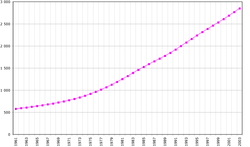|  In
Oman, about 50% of the population lives in Muscat and the Batinah
coastal plain northwest of the capital; about 200,000 live in
the Dhofar (southern) region, and about 30,000 live in the remote
Musandam Peninsula on the Strait of Hormuz. Some 600,000 expatriates
live in Oman, most of whom are guest workers from India, Pakistan,
Bangladesh, Egypt, Jordan, and the Philippines. In
Oman, about 50% of the population lives in Muscat and the Batinah
coastal plain northwest of the capital; about 200,000 live in
the Dhofar (southern) region, and about 30,000 live in the remote
Musandam Peninsula on the Strait of Hormuz. Some 600,000 expatriates
live in Oman, most of whom are guest workers from India, Pakistan,
Bangladesh, Egypt, Jordan, and the Philippines.
Since 1970, the government has given high
priority to education to develop a domestic work force, which
the government considers a vital factor in the country's economic
and social progress. In 1986, Oman's first university, Sultan
Qaboos University, opened. Other post secondary institutions include
a law school, technical college, banking institute, teachers training
college, and health sciences institute. Some 200 scholarships
are awarded each year for study abroad.
Nine private colleges exist, providing
2-year post secondary diplomas. Since 1999, the government has
embarked on reforms in higher education designed to meet the needs
of a growing population, only a small percentage of which are
currently admitted to higher education institutions. Under the
reformed system, four public regional universities will be created,
and incentives are provided by the government to promote the upgrading
of the existing nine private colleges and the creation of other
degree-granting private colleges.
Population: 3,001,583
note: includes 577,293 non-nationals (July 2005 est.)
Age structure:
0-14 years: 42.6% (male 652,028; female 626,698)
15-64 years: 54.9% (male 978,183; female 668,814)
65 years and over: 2.5% (male 41,366; female 34,494) (2005 est.)
Population growth rate: 3.28% (2006 est.)
Birth rate: 36.73 births/1,000 population
(2005 est.)
Death rate: 3.86 deaths/1,000 population
(2005 est.)
Net migration rate: 0.31 migrant(s)/1,000
population (2005 est.)
Sex ratio:
at birth: 1.05 male(s)/female
under 15 years: 1.04 male(s)/female
15-64 years: 1.46 male(s)/female
65 years and over: 1.2 male(s)/female
total population: 1.26 male(s)/female (2005 est.)
Infant mortality rate: 19.51 deaths/1,000
live births (2005 est.)
Life expectancy at birth:
total population: 73.13 years
male: 70.92 years
female: 75.46 years (2005 est.)
Total fertility rate: 5.84 children born/woman
(2005 est.)
Urbanisation: About 78% of the population
is urban.
Nationality:
noun: Omani(s)
adjective: Omani
Ethnic groups: Arab, Baluchi, South Asian
(Indian, Pakistani, Sri Lankan, Bangladeshi), African
Religions: Ibadhi Muslim 75%, Sunni Muslim,
Shi'a Muslim, Hindu
Languages: Arabic (official), English,
Baluchi, Urdu, Indian dialects
Literacy:
definition: NA
total population: 75.8%
male: 83.1%
female: 67.2% (2003 est.)
|